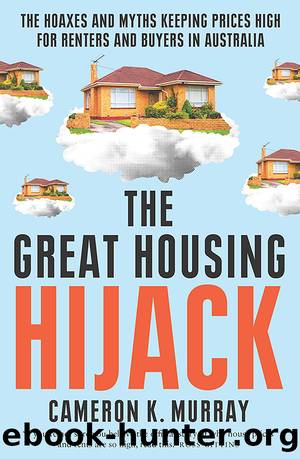The Great Housing Hijack by Cameron K. Murray

Author:Cameron K. Murray [Cameron K. Murray]
Language: eng
Format: epub
Publisher: Allen & Unwin
Published: 2024-01-02T00:00:00+00:00
A common view is that governments âreleaseâ land to the market. But the ânew land releaseâ signs I see beside the highway are all from private property developers who own the land, not the council or the state government, who donât own the land. Yes, governments have planning and zoning rules about what can be built at each location. But only property owners can decide when and if to build new housing.
The planning system and its zoning rules do not regulate how fast new homes are built. There are no speed limits. What town plans do is regulate where different types of immobile buildings can go, just as lane markings on the road regulate where mobile objects can go. Regulating the spatial use of roads improves coordination and, if done well, planning rules improve coordination by regulating the spatial use of property when it comes to erecting buildings, but also developing major works like mines, ports and roads, among many other projects.
The creation of planningâand zoning in particular, which is a set of rules that describe the as-of-right building types and activities allowed on property in certain areasâhappened in the early and mid-twentieth century. Before this, owners in the property monopoly were able to create similar regulations using covenants. Property owners could attach a covenant, which is a type of contact, to their property title to restrict what future owners could do with the property.1 These pre-zoning rules offered legal protection from nuisance to nearby property owners, and they also regulated the location of housing and other land uses.
United States housing researchers John Quigley and Larry Rosenthal explained that the emergence of planning and zoning there was partly to override existing legal protections and to enable large-scale land development. They wrote: âBefore the 1920s, experimentation with planning and zoning in U.S. cities and towns was sparse and arose primarily as a consequence of the desires of large-tract residential developers to eliminate industrial and commercial activities in their path.â2
In Australia, modern planning and zoning emerged from the slum conditions seen in the early twentieth century through to the 1930s Great Depression, and from later efforts to coordinate large-scale catch-up development in the cities after World War II.
The idea that planning regulations and zoning constrain the absorption rate of new housing and lead to higher rents and prices is based on a distorted view of how the planning system operates and interacts with the economic choices of property owners.
Download
This site does not store any files on its server. We only index and link to content provided by other sites. Please contact the content providers to delete copyright contents if any and email us, we'll remove relevant links or contents immediately.
| Buying & Selling Homes | Investments |
| Law | Mortgages |
| Sales |
Investing For Dummies by Eric Tyson(2480)
The Book on Rental Property Investing by Turner Brandon(1408)
The Book On Tax Strategies for the Savvy Real Estate Investor by Amanda Han & Matthew MacFarland(1349)
Every Landlord's Legal Guide by Janet Portman & Stewart Marcia & Ralph Warner(1334)
The Thibaults by Roger Martin Du Gard(1313)
Personal Finance For Dummies (9th Edition) by Eric Tyson(1276)
Real Estate Licensing Exams by Raymond D. Modglin(1155)
Investing 101 by Michele Cagan(1095)
Bill Bryson by At Home(1075)
The Real Book of Real Estate by Robert T. Kiyosaki(1040)
The Plaza by Julie Satow(1036)
Irrational Exuberance by Shiller Robert J. J(1033)
7 Steps to Wealth by John L. Fitzgerald(970)
Mortgages 101 by David Reed(966)
Real Estate Math Demystified by Steven P. Mooney(952)
The Business of Flipping Homes by William Bronchick(945)
Now I Sit Me Down by Witold Rybczynski(925)
Retail Development by Anita Kramer(912)
SAP Flexible Real Estate Management by Jayant Daithankar(911)
